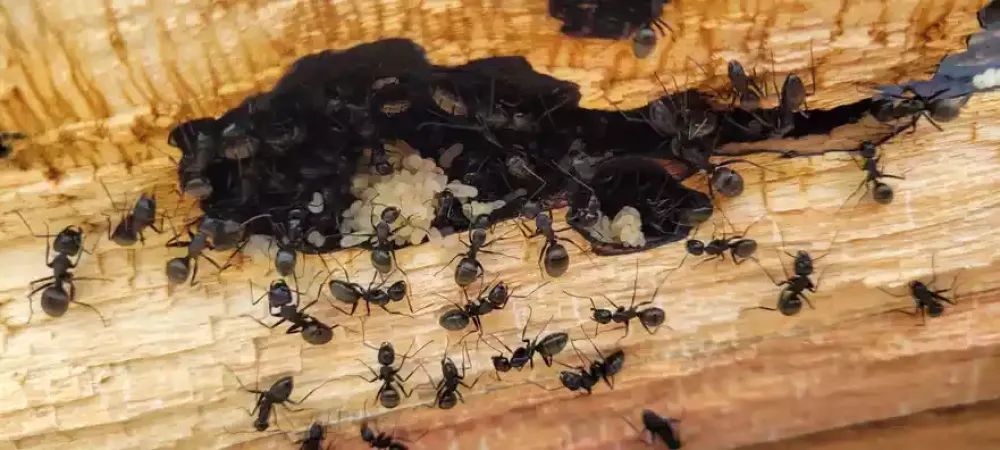What Are Carpenter Ants?

Delaware and Maryland combined host several million acres of forested area. Many service requests we receive are for Big Black ants. Customers describe big black ants roaming around their home. Our office has experienced an increase in “Big Black Ants in my kitchen” service requests. After a thorough inspection and identification, we often find that the big black ant the customer is describing is the wood destroying insect, the notorious Carpenter Ant. Carpenter ants are social insects that excavate wood and are common invaders of homes in the northeastern United States.
Carpenter ant workers are dark shiny brown to black in color and ¼ to ½ inch in length. Often the first sign of a carpenter ant infestation is the presence of large ½ inch dark-colored foraging worker ants in or around a home. During warmer months foraging workers are often seen at night. Many foraging worker ants entering the structure may only be in search of food and water and may not be taking up residence inside the structure. The presence of piles, of course, stringy wood particles and dead insect parts is often an indication of a carpenter ant colony infestation. Carpenter ants do not consume wood for food. They excavate wood for colony expansion by dumping the particles outside the nest.
Carpenter ant colonies consist of many casts or members that contribute to the growth of the colony and its expansion. Members of the colony include a wingless queen, several sterile wingless female workers and many polymorphic minors and major workers. A queen lays fifteen to twenty eggs which take a minimum of sixty days to develop. Carpenter ant eggs are white with tan pupae cocoons. A mature carpenter ant colony takes about 3 to 6 years to form and contains about 2,000 to 3,000 or more individuals. About 200 to 400 winged reproductives (often referred to as Flying Ants) emerge or swarm primarily on warm days in the spring and early summer. Mating occurs during a brief flight, after which the male dies and the female (queen) removes her wings and searches for a suitable nesting site. Carpenter ants remain in the nest for the winter months unless the nest is located in a heated portion of a building.
Where To Find Carpenter Ants?
Carpenter ants will nest in a diversified array of nesting sites. Stumps, hollow logs, fence posts or any wooden member that is partially decayed or is compromised by moisture are just a few examples. We find most often, the primary nest, where the queen is located, will be up to 100 yards away from the home. Likely any nest(s) inside a building are secondary or satellite colonies. Worker ants will travel between satellite and parent colonies. Considered a wood destroying insect, carpenter ants excavate nest galleries in wood but they do not consume it. They prefer sweets and are predacious on other insects, such as aphids and other insects, even termites. Carpenter ants prefer the softer areas when cutting their galleries along the wood grain. Carpenter ant damage can often be mistaken for termite damage. However, carpenter ant damage or galleries are smooth and meticulously maintained by piling or dumping the excavated wood frass, insect parts, and pupal casing out of the nesting area.
Treatment
Carpenter Ants are different than other pest ants. The most important key to any ant control or eradication is species identification and inspection which cannot be done over the phone. It is our policy to identify the insect(s) in question, note all conducive conditions that may contribute to the infestation, communicate all options and devise a plan to rid your home of the infestation and keep it from reoccurring. After identification, the best approach to eliminating an ant infestation is to first correct or repair the conducive conditions in and around the structure.
Any area of the home or structure that is being compromised by moisture is vulnerable to insect infestation, especially carpenter ants and needs to be addressed. In addition, trim and prune all trees and shrubs that may come in contact with the home. Also relocate any firewood or wood stored items as far away from the home or structure as possible. Furthermore, keeping the perimeter of the home free from debris and or leaf litter will aid in the elimination of any pest infestation.
Activ Pest Solutions is Dedicated and Trained to communicate as many methods of Non- Chemical pest elimination as possible before treating your home with any insecticide applications. Our free thorough inspection by a certified professional technician will identify and discuss all areas that might be conducive conditions which will aid in Carpenter ant elimination. The second method of control is to eliminate or exterminate the parent colony and satellite colonies. It is important to understand that it is unlikely that the satellite colony can be eliminated without the use of one or more materials applied by a certified professional technician. Our Activ certified professional technician will provide you with a detailed plan to eliminate the carpenter ant problem and can control it from future reoccurrence.
All Ant Infestations are a royal Pain but not all Treatments are the Same! Call Activ Pest Solutions Today at (302)645-1502 or Contact Us to get your Free Inspection
